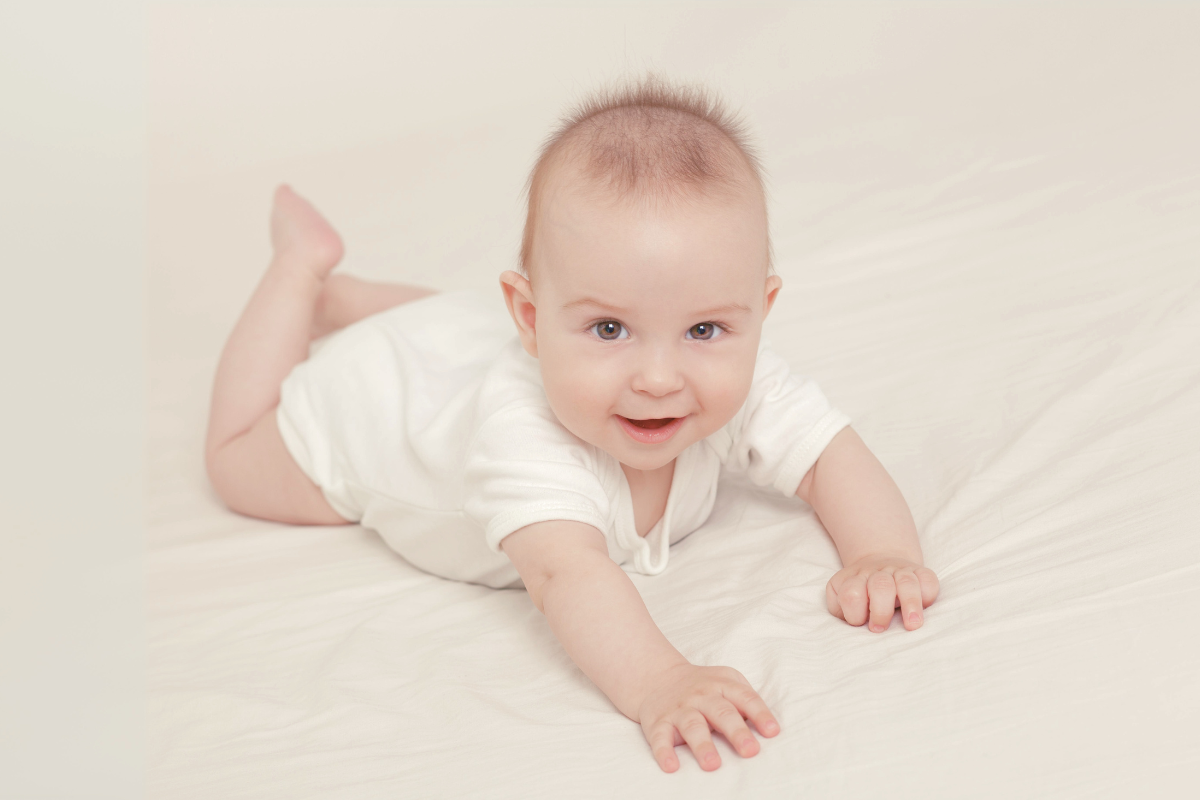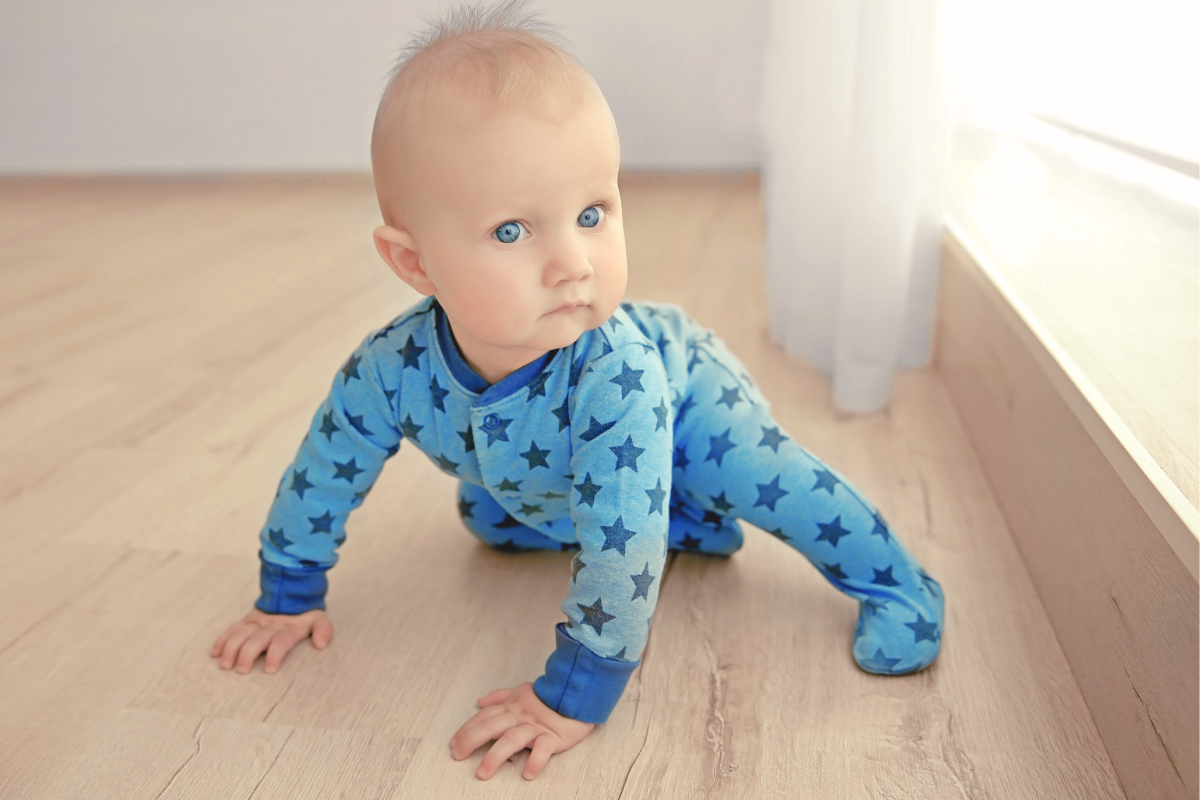How to Help Infant Crawl: 20 Tips to Encourage Crawling
Helping your infant reach the exciting milestone of crawling is a journey filled with joy and discovery.
In this article, we'll share 20 expert tips to encourage your baby's crawling skills. From creating a safe and engaging environment to practicing specific activities, these tips are designed to support your baby's development and make the crawling stage a fun and rewarding experience for both of you!
Why Should You Encourage Your Baby to Crawl?
Encouraging your baby to crawl is more than just a milestone; it's a crucial part of their development. Here are some reasons why.
-
Speeds up motor skill development. Studies show that when babies crawl, they tend to start walking sooner as well. In one study, it was found that babies who knew how to crawl walked almost a month earlier than those who could only scoot forward on their bottoms.
-
Boosts mental and cognitive development. Crawling boosts the link between physical actions and brain signals, helping with neurological coordination.
-
Enhances future physical health. A research study found that children who crawled as babies were more likely to develop better physical health by age 7. Additionally, starting with crawling could positively influence their fat-to-muscle ratio and heart health, leading to better overall health as they grow.
-
Helps with sensory development. The act of crawling encourages proprioception (muscle and joint feedback), vestibular (balance), and other senses, promoting exploration.
-
Improves eye-hand coordination. Develops as your baby reaches for toys and navigates their environment.
-
Expands vision. Crawling encourages babies to move their heads and explore their surroundings, broadening their visual experiences and sparking curiosity.
20 Tips to Help Babies Crawl
Ready to support your baby's crawling journey? Here are 20 practical tips to help babies start crawling!
1. Start With Tummy Time
Tummy time can begin from birth with short, supervised sessions on the floor. This baby body-building workout strengthens the neck, arms, shoulders, and torso, which are all essential for crawling.
Initially, try only a minute at most on a flat surface floor. Gradually increase the time as your baby grows stronger. Newborns can handle 3-5 minute sessions of tummy time 3-4 times a day. This increases to 15-20 minutes at a time for three-month-old babies and 20-30 minutes for six-month-olds.
Eventually, you'll notice them trying to stand on their hands and feet, spin in circles, or rock back and forth. Some babies might even move forward a step on their bellies or hands and knees. These movements are essential for developing the muscle control needed for crawling.
2. Be More Supportive During Tummy Time

Not all babies enjoy tummy time initially, but providing gentle support during tummy time can make it more fun and beneficial for your baby.
Here are some ways that you can support your baby:
-
Place a rolled-up towel under their chest or their armpits.
-
Put your hand below your baby's head to provide even more support.
-
Position them over your leg while you're in a sitting position on the floor with your leg stretched out in front of you.
-
Let your baby lie on your stomach and see your face, which also helps with parent-baby bonding.
If your baby still protests tummy time, shorten the duration and mix up their positions more -- switching from back to side to belly.
3. Foster an Optimal Environment

You also need to give your baby plenty of space to explore and progress in their crawling stages. Don't let them simply lay in their baby crib -- give them plenty of chances to pull, grasp, and push objects around.
To keep them comfortable and safe at the same time, place your baby on a clean towel or blanket on the floor. You can also use a mat specifically made for babies, like the Poppyseed Play Padded Baby Plat Mat or the Quilted Linen Play Mat option.
Remember, never let your baby do tummy time unsupervised. Always supervise them whenever they're on their belly.
4. Limit Use of Supportive Equipment
Avoid using highchairs, bouncers, baby walkers, and other supportive equipment more than necessary, as they can limit your baby’s movement and leg muscles development.
Babies are new to gravity and need practice holding their weight. Spending too much time in supportive devices can slow their progress -- it's best to let your baby learn how to coordinate movements from experience.
If you want to know more about the best equipment and how it can help motor skills, check out this guide.
5. Prioritize Their Safety
As your baby starts to crawl and move around, baby-proofing your house becomes a top priority. Here are some steps to create a safe environment for your baby's crawling stage:
-
Use safety locks on cabinets and drawers
-
Put away small choking hazards and potentially toxic items
-
Cover the edges of your coffee table or other furniture your child can bump into
-
Put houseplants and other heavy objects out of your baby's reach
-
Add covers to outlets to prevent curious hands from inserting fingers or objects into them
-
Remove strangulation risks by moving or covering cords and cables
-
Secure large furniture to the wall to prevent tipping accidents
-
Install baby gates at stairs, closing off both the top and bottom
Additionally, we recommend making the floor carpeted or padded to make it more comfortable for your infant.
And once again remember: always supervise them and never leave them unattended when they're doing this, not even for a minute.
6. Demonstrate Baby Crawling Movements

You can also help your baby learn to crawl by demonstrating the movements yourself.
Get down on the floor and do push-ups facing your baby to show how to push up from their belly. Show them how to get into the crawling position by placing them on their hands and knees and gently rocking back and forth.
There are two main types of crawling: belly crawling and criss-cross crawling (or hands and knees crawling). Criss-cross crawling involves moving their arms and legs in a diagonal pattern, which helps babies develop important brain pathways.
On the other hand, belly crawling, where the baby keeps their belly on the floor, often starts earlier since it requires less strength and balance. Research shows that babies who previously belly crawled were more proficient at crawling on hands and knees than those who skipped the belly-crawling period.
7. Encourage Different Crawling Styles and Positions
Helping your baby start exploring different crawling styles and positions can go a long way. Here are some of the starter positions to get your baby ready for crawling.
-
Hands and Knees. Help your baby get used to being on all fours by placing them on their belly over one of your legs, so both their hands and knees are touching the floor. Gently hold their hips off the floor and back toward their heels to get them into the crawling position.
-
Tall Kneel. Babies start tall kneeling starting at around 8-9 months. This is when your baby’s bottom is lifted off their heels, working their core muscles and helping them practice balance. You can place toys on a low surface to encourage them to reach for it by lifting their bottom.
-
Sidesitting. This intermediate position between sitting and crawling is great for developing core strength. Have your baby sit with one leg bent in front and the other behind, with both feet pointing in the same direction. When they reach for their toy, they'll shift their center of gravity and put one or both hands on the floor for support.
Aside from these positions, there are also different crawling styles that babies begin doing once they learn to crawl. Here are some of the common ones:
-
Classic crawl. To crawl forward on hands and knees, alternating opposite limbs.
-
Bear crawl. The baby crawls with straight arms and legs, just like how a bear would normally walk.
-
Commando crawl. Also known as the belly crawl or the army crawl, commando crawling involves dragging the body forward while keeping the belly flat on the floor.
-
Crab crawl. It's when babies crawl by moving sideways or backward using one arm and one leg.
-
Rolling crawl. This is when a baby rolls over repeatedly to move across the floor.
8. Recognize Signs of Readiness in Most Babies

It can be incredibly exciting to see the signs that your baby is ready to start crawling.
Of course, it's important to note that not all babies take on this developmental path. Some babies skip crawling completely, which is why the Centers for Disease Control and Prevention (CDC) removed crawling as a child development milestone in early 2022.
That said, it's also true that many babies do go through a crawling stage. Here are some of the signs you should watch out for to know if your baby is ready to begin crawling.
-
Scooting forward or backward on their belly
-
Rocking back and forth on their hands and knees
-
Pushing up onto their hands and knees
-
Lifting their belly off the ground while on a hands and knees position
-
Doing push-ups during tummy time
-
Sitting without support
-
Rolling over while lying down
-
Looking around the room during tummy time
9. Provide Comfy Clothing
Dressing your baby in appropriate clothes can also help them get a good grip on the floor.
For instance, if your home has uncarpeted floors, consider dressing your baby in long sleeves and pants to reduce friction.
Avoid putting them in socks and leggings when on a hard, smooth surface as it can be too slippery. Besides, if you keep their knees and toes exposed, they'll have better traction.
10. Join Your Baby On The Floor
Being an active participant in what your baby is doing is a great way to motivate them to continue. If you want your baby to crawl earlier, for instance, the easiest way to do it is to simply join them on the floor.
Babies learn from imitation, and they'll want to keep up as you get from point A to point B. This means your baby might start crawling sooner if they see you or an older sibling doing it.
So, be their biggest cheerleader with smiles and enthusiastic encouragement. Sometimes, a little demonstration from you is all they need to get moving.
11. Use Toys as Motivation

Toys can serve as a great motivator for your baby to start crawling.
During tummy time, place your baby's favorite toys just out of reach. Noisy or light-up toys can be especially effective at catching your baby's attention. As your baby becomes more comfortable with crawling, move different toys to various locations in the room.
This variety keeps them engaged and helps them practice moving in different directions, preventing boredom.
12. Let the Baby Go to You
Every baby reaches developmental milestones in their own time -- including gross motor skills like crawling. That said, experience is the best teacher, so one thing you can do is to stand back as your baby learns how to do it on their own.
Stand a short distance away from your baby and encourage them to reach or crawl towards you. Be patient and supportive as they attempt to move. You can even play peekaboo to make it more fun. If they're having a hard time, be sure to give them some slack and cheer them on.
13. Engage in Baby-Led Play
Baby-led play supports your little one's curiosity and boosts their confidence as they discover new ways to move.
Allow your baby to play freely and explore their own interests. This encourages natural movement and helps them develop the skills they need to start crawling.
14. Add Mirrors to Spark Interest

Baby-safe floor mirrors are a wonderful way to inspire crawling. Place a mirror on the floor where your baby can see their reflection.
Infants are fascinated when they see the "other baby" in the mirror, which can motivate them to move closer and practice the movements needed for crawling. Mirrors provide visual stimulation and make tummy time more fun.
15. Utilize Different Surfaces
Let your baby crawl on different textures to create a more sensory-driven experience. Allow them to crawl safely on carpet, hardwood floors, grass, or sand.
Various surfaces will help them develop better balance and coordination while making the process more engaging and interesting.
16. Set Up Play Equipment
Make crawling practice fun and engaging for your baby by incorporating play equipment. Create a safe obstacle course using pillows and tunnels.
Crawling through tunnels stimulates curiosity and physical activity. You can buy a play tunnel or make one by draping a blanket over two kitchen chairs. These interactive spaces encourage your child to explore and move.
Consider investing in other great play equipment like the Poppyseed Play Baby Bundle, Play Gym Set, and the Wooden Baby Gym. These tools not only provide safe spaces for your baby to crawl but also encourage them to reach, grab, and pull, further developing their motor skills.
197. Make it Fun with Music and Play
Play music and rock on your hands and knees to encourage your baby to crawl. Engage in playful activities that promote movement, making the learning process enjoyable for both of you. Music and play can turn crawling practice into a fun bonding experience.
18. Explore the Outdoors
Allow your baby to crawl on grass or sand to experience new environments and feel different textures. Take trips to the park for new sights and sounds, stimulating their senses.
This not only encourages crawling but also provides a wonderful opportunity for exploration. As your baby grows into an active toddler, they may want to spend less time outdoors. For indoor activities that promote gross motor skills, check out this great list of engaging indoor gross motor activities.
19 Practice Patience and Positive Reinforcement
Celebrate each small milestone with plenty of praise and encouragement. Your little one will experience a range of emotions as they learn to crawl—excitement with new discoveries, sadness when something is taken away, and frustration with obstacles.
Be patient and supportive, recognizing that each step forward, no matter how small, is a significant achievement. Positive reinforcement helps build your baby's confidence and keeps them motivated to continue practicing their new skills, even in the face of challenges.
20. Consult a Professional if Needed
If you have any concerns about your baby's development, consult a pediatrician or occupational therapist.
For example, if your baby is not rolling or shuffling along the floor by seven to eight months, it may indicate a gross motor delay, and early intervention could be helpful. That said, some babies do skip crawling altogether and proceed straight to walking, so there's no need to panic.
Still, discussing the issue with your healthcare provider can reassure you of your baby's normal progression. Addressing any concerns early can put your mind at ease and help you support your baby's growth and milestones.
Final Thoughts
As you can see, there are many ways for you to help your infant crawl. Whether you're just an excited parent or if you think your child may be a little delayed compared to his peers, these tips should help you out. We hope you enjoy this beautiful journey with your baby!




